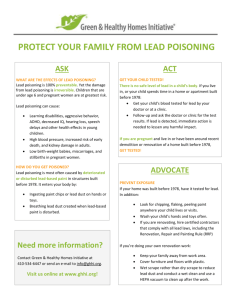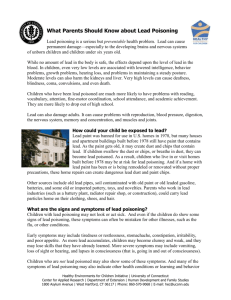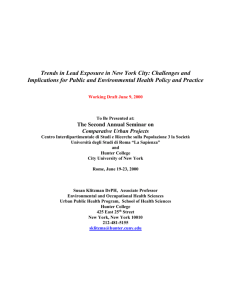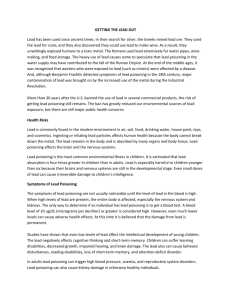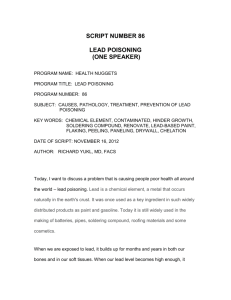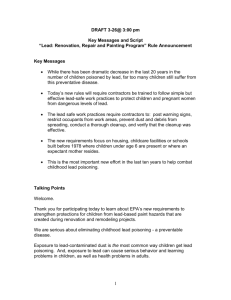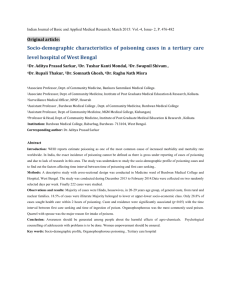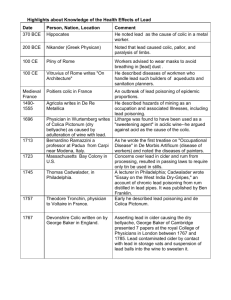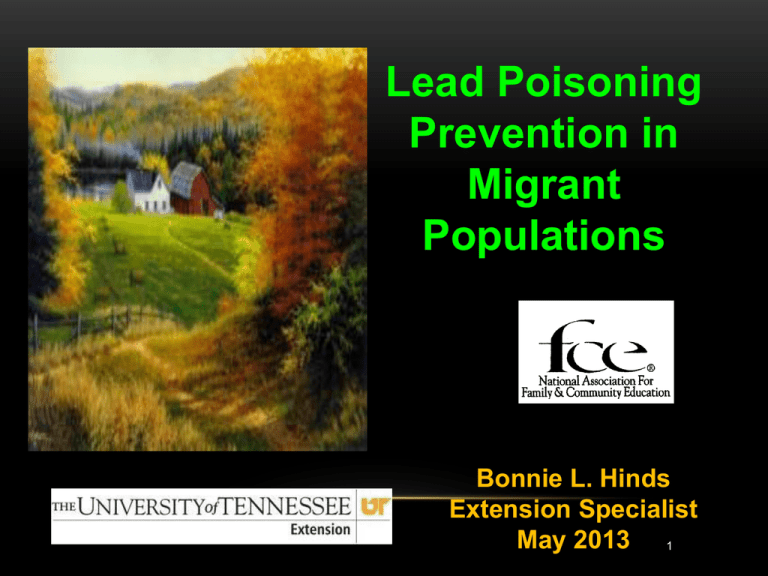
Lead Poisoning
Prevention in
Migrant
Populations
Bonnie L. Hinds
Extension Specialist
May 2013 1
In 2013, lead poisoning remains
the #1 environmental threat to
the health of America’s children,
as well as a health risk for
people of all ages.
2
Migrant workers and their families
are likely encounter heightened risks
of lead poisoning.
3
Leading Cause of Lead Poisoning
ADULTS
Ninety-five (95) percent of all adult
lead poisonings are related to occupational
exposure.
4
Lead in SOIL
5
Leading Cause of Lead Poisoning
CHILDREN
Lead poisoning in children is
most often associated with
deteriorating lead-based
paint in the home.
6
Because lead was
not abolished for
use in house paint
until 1978, any
home built before
that time may
contain lead-based
paint.
Conservative estimates indicate that at least
25 percent of all American housing was built
before 1978.
7
Lead-Based Paint DUST
Intact (encased) leadbased paint may not be
problematic.
Areas, however that are
vulnerable to weathering and
friction (such as windows and
doors) present major risks.
Leaded paint degrades into fine,
virtually invisible
lead dust.
8
Lead Exposure
Ingestion
9
The inhalation of lead
DUST is the most
common and
troublesome method of
exposure.
It takes only a tiny
amount of dust to
poison a child. Lead
dust is virtually
invisible.
10
Lead Absorption
•
Children absorb 50 percent of ingested lead
and retain at least 30 percent.
•
Adults absorb 15 percent of ingested lead and
retain less than 5 percent.
•
Both children and adults absorb and retain
as much as 70 percent of inhaled lead.
•
Lead is stored in the kidneys, liver, bones
(marrow), and brain. A healthy diet, low in
fat and rich in calcium and iron, will help
inhibit lead absorption.
11
Lead poisoned mothers have lead poisoned
babies, as lead crosses the placental barrier.
12
A home’s water supply may
also be affected if the plumbing
is copper.
Lead solder usually seals
connection joints. This lead can
leach into the water,
particularly when water is
heated.
13
Lead in Consumer Goods
Lead is found in the glaze of much Mexican
pottery; it provides stability to vinyl and plastic,
and confers flame retardancy to a number of
household products.
14
Physical Symptoms of Lead Poisoning:
Sleep disturbances
Headache
Hearing impairment
Digestive problems
Kidney damage
Anemia
More commonly, children show
no signs of physical illness
whatsoever.
However . . .
15
Children’s Brain Development
Fully 90 percent of a child’s
brain development is
accomplished by the age of
FIVE.
While blood lead levels can
be decreased by removing
the source of exposure,
neurological damage is
Lead poisoning results in
irreversible.
diminished IQ.
16
Socio-Behavioral Effects of
Lead Poisoning
• Irritability
• Aggression
• Hyperactivity
• Diminished
attention span
• Criminal and
violent behavior
• Reduction in graduation rates and
educational attainment.
17
Lead “Reference Value” – May 2012
Lead poisoning is determined by measuring the
amount of lead in an individual’s blood.
Reference values are in micrograms of lead
per deciliter of blood (µg/dL).
Until May of 2012, the blood lead level of concern
for children was 10 µg/dL. Following the
recommendation of an advisory committee, the
CDC officially lowered the level
to 5 µg/dL in acknowledgement of mounting
evidence that shows significant neurological
damage is occurring at these lower levels.
18
Lead poisoning is 100% preventable!!
Keep floors, window frames, and
window sills CLEAN with
soap/household cleaner and
warm water.
Keep children’s hands CLEAN
(especially before meals) with
soap and warm water.
19
Follow lead testing guidelines!
The state of Tennessee and the
American Academy of Pediatrics
recommend a routine blood test
for all children at the age of
12 and 24 months.
It requires only a capillary blood test
(finger prick).
20
Questions? Additional Information?
Bonnie L. Hinds
bhinds@utk.edu
865-974-8178
fcs.tennessee.edu/lead
Contact me for free materials in English
and/or Spanish!
CDC – www.cdc.gov/nceh/lead
EPA – www.epa.gov/lead
21


